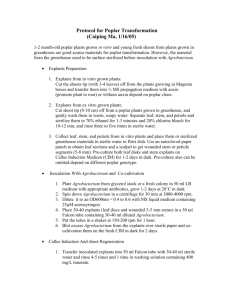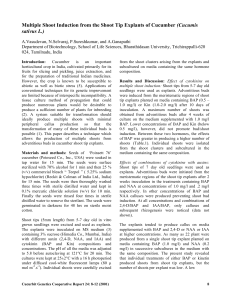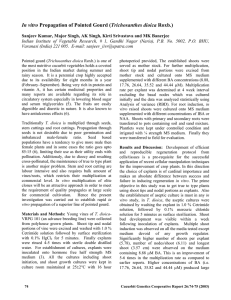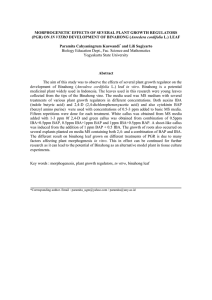Document 14671067
advertisement
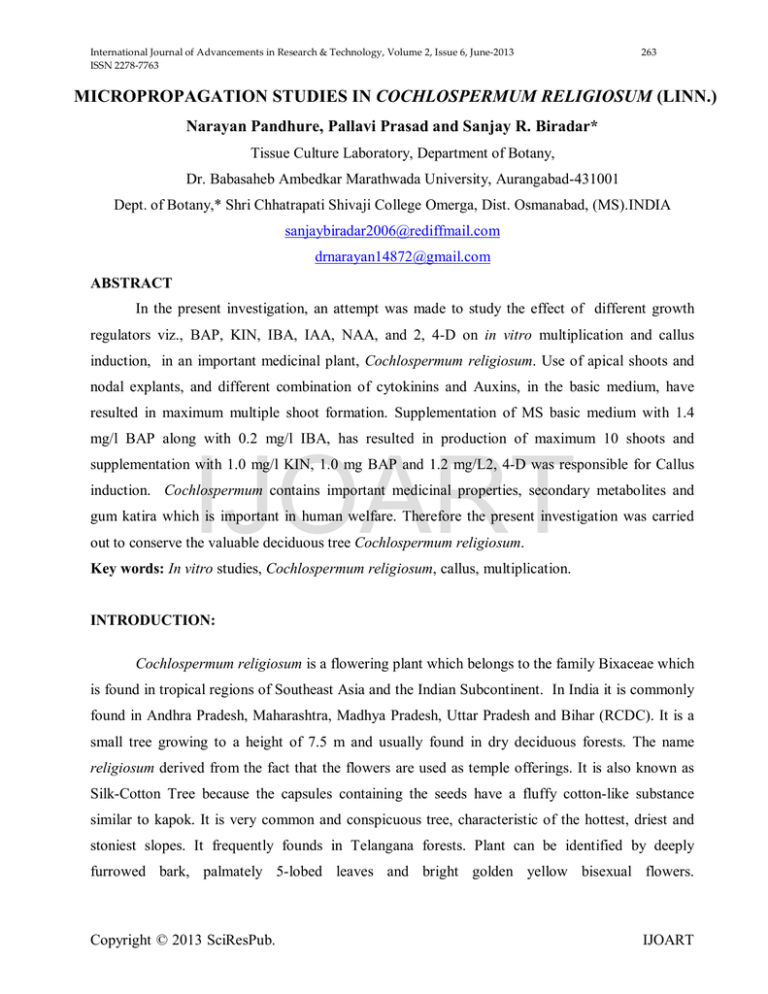
International Journal of Advancements in Research & Technology, Volume 2, Issue 6, June-2013 ISSN 2278-7763 263 MICROPROPAGATION STUDIES IN COCHLOSPERMUM RELIGIOSUM (LINN.) Narayan Pandhure, Pallavi Prasad and Sanjay R. Biradar* Tissue Culture Laboratory, Department of Botany, Dr. Babasaheb Ambedkar Marathwada University, Aurangabad-431001 Dept. of Botany,* Shri Chhatrapati Shivaji College Omerga, Dist. Osmanabad, (MS).INDIA sanjaybiradar2006@rediffmail.com drnarayan14872@gmail.com ABSTRACT In the present investigation, an attempt was made to study the effect of different growth regulators viz., BAP, KIN, IBA, IAA, NAA, and 2, 4-D on in vitro multiplication and callus induction, in an important medicinal plant, Cochlospermum religiosum. Use of apical shoots and nodal explants, and different combination of cytokinins and Auxins, in the basic medium, have resulted in maximum multiple shoot formation. Supplementation of MS basic medium with 1.4 IJOART mg/l BAP along with 0.2 mg/l IBA, has resulted in production of maximum 10 shoots and supplementation with 1.0 mg/l KIN, 1.0 mg BAP and 1.2 mg/L2, 4-D was responsible for Callus induction. Cochlospermum contains important medicinal properties, secondary metabolites and gum katira which is important in human welfare. Therefore the present investigation was carried out to conserve the valuable deciduous tree Cochlospermum religiosum. Key words: In vitro studies, Cochlospermum religiosum, callus, multiplication. INTRODUCTION: Cochlospermum religiosum is a flowering plant which belongs to the family Bixaceae which is found in tropical regions of Southeast Asia and the Indian Subcontinent. In India it is commonly found in Andhra Pradesh, Maharashtra, Madhya Pradesh, Uttar Pradesh and Bihar (RCDC). It is a small tree growing to a height of 7.5 m and usually found in dry deciduous forests. The name religiosum derived from the fact that the flowers are used as temple offerings. It is also known as Silk-Cotton Tree because the capsules containing the seeds have a fluffy cotton-like substance similar to kapok. It is very common and conspicuous tree, characteristic of the hottest, driest and stoniest slopes. It frequently founds in Telangana forests. Plant can be identified by deeply furrowed bark, palmately 5-lobed leaves and bright golden yellow bisexual flowers. Copyright © 2013 SciResPub. IJOART International Journal of Advancements in Research & Technology, Volume 2, Issue 6, June-2013 ISSN 2278-7763 264 Cochlospermum is the genus of trees and shrubs scattered throughout the tropics mostly xerophytes, deciduous in drier season. Capsules containing numerous seeds some species are medicinal, Ornamental, yielding floss, fibre, gum and timber. Cochlospermum quick growing tree yield a gum known as gum katira from a juice orange in colour exudes from the bark. This gum has been exported from India in increasing quantities in recent years and the fact that the price has been low and stable, as compared with tragacanth, has led to new uses and applications for it in industry and pharmacy. Katira is primarily used as a substitute of Tragacanth in most American countries. There are lot other uses of Katira like in calico-printing, polishing paper and leather dressing. It is also used for polishing tusser silk. It is exported to many countries of Latin America to use in cigar and Ice cream industries. As a laxative it is considered to be superior to other gums. As an emulsifying agent it is a good substitute for tragacanth. This gum is used in medicine for the treatment of cough, diarrhea and dysentery. The dried leaves and flowers are used as stimulants, antipyretic, laxative and IJOART sedative (Kirtikar and Basu, 1975). Root powder mixed with water applied to face reduce wrinkle ( Sikarwar, et al., 2007). The oral gum powder about 20g mixed with ghee works as an aphrodisiac (Savithramma N. et al., 2011). Katira used in cosmetics and for bookbinding the floss is used for stuffing pillows, mattresses, cushions, life jackets. Seed cakes are used as manure and cattle feed. Bark Powder of tree is used with water during jaundice (Dinesh and Aruna, 2010). Cochlospermum is propagated by seed broadcast, seeds are broadcasted in primary beds in June and seedlings are pricked out to polythene bags when six months old. Therefore present research work aim to conserve important medicinal plant Cochlospermum religiosum through in vitro tissue culture techniques. MATERIAL AND METHODS Preparation of Explants: Seeds of Cochlospermum religiosum were collected from Buldhana district and grown in the green house of Botanical garden, Department of Botany, Dr. Babasaheb Ambedkar Marathwada University, Aurangabad. Apical shoots, axillary leaves and nodal explants of Cochlospermum were collected from 30 days old plants grown in the greenhouse of Departmental Botanical garden. The explants were washed carefully in running tap water for 5 minutes and followed by distilled water for 5 minutes. Explants were surface sterilized for 5 minutes with 0.3% mercuric chloride, followed by three subsequent rinses with sterilized double distilled water, in a laminar air flow. All these Copyright © 2013 SciResPub. IJOART International Journal of Advancements in Research & Technology, Volume 2, Issue 6, June-2013 ISSN 2278-7763 265 explants were dissected into small pieces and inoculated on culture vessel and test tube containing 25 ml sterilized MS medium. Culture media MS (Murashige and Skoog, 1962) medium was used for multiple shoot formation and apical shoots, Axillary buds and nodal parts were used as explants. MS medium was supplemented with various growth hormones viz., BA and KIN and for rooting, half strength MS medium was supplemented with various concentrations of auxins like IAA, IBA, and NAA were examined. MS medium containing 3% sucrose and gelled with 2.5% Clerigel, pH was adjusted to pH 5.8 after addition of growth regulators. The media were steam sterilized in an autoclave under 15 psi and 121° C for 20 minutes. After autoclaving, the vessels containing the media were transferred to aseptic conditions in laminar air flow for inoculation. Culture conditions After inoculation, culture tubes and vessels were transferred to culture room under a 10 h IJOART photoperiod supplied by cool white fluorescent tube lights and 25 ± 20C temperatures. At least ten cultures were raised for each treatment. Data record Data was recorded after 30days. Mean (µ) values with the standard error (S.E.) were calculated from five replicates each for callus induction, shoot multiplication and shoot length. RESULTS AND DISCUSSION Surface sterilization of explants is necessary to disinfect tissues with a minimum amount of cellular damage to the host tissue (Conger 1987). Therefore the explants were cut in proper size and shape, surface sterilized and aseptically inoculated on MS medium. MS media in different concentrations with BAP 1.0, 1.5, 2.0, 2.5, 3.0, mg/l and IBA, NAA (0.2mg/L) produced maximum average percentage of shoot multiplications. Combination of BAP and 2, 4-D yield better results for callus induction as compared to any other combination of growth regulators. It is noticed that Cochlospermum religiosum has produced maximum in vitro shoots at low temperature. Copyright © 2013 SciResPub. IJOART International Journal of Advancements in Research & Technology, Volume 2, Issue 6, June-2013 ISSN 2278-7763 (a) 266 (b) IJOART (c) (e) (d) (f) Photo plate: 1- showing fig. (a)Callus induction on axillary leaves explant, fig. (b)Callus induction on apical shoot explant, fig. (c)Callus with shoot initiation, fig. (d) Multiple shoots formation on apical shoot explant; fig. (e) Shoots formation onNodal explant, fig. (f) Well growing culture. Copyright © 2013 SciResPub. IJOART International Journal of Advancements in Research & Technology, Volume 2, Issue 6, June-2013 ISSN 2278-7763 267 Various explants were tried in MS medium supplement with 3% sucrose 2.5% clerigel in combination with growth regulators viz. 2, 4-D and BAP as shown in table 1. Maximum callus induction was observed in 1.0 mg/l BAP and 1.5 mg/L, 2, 4-D using shoot tip as explants, followed by1.0 mg/l BAP in combination with 1.0 mg/l, 2, 4-D using Axillary leaf explants. Both these calli are compact and yellowish in colour. When concentration of growth regulators was increased (Table No. 1) subsequently there was a decrease in the induction of callus formation in Cochlospermum religiosum. Shoot initiation (organogenesis) was observed after 30 days in the callus, subcultured on MS medium containing BAP. The callus, subcultured on MS medium supplemented with BAP, in combination with different auxins, has showed no effect on shoot induction. Table.1 Effect of BAP and 2, 4-D on callus induction using various explants Source of explant Growth regulators Mg/l Frequency FreshWeight Dry weight Of callus (gm) (gm) formation µ ±SE µ ±SE IJOART No of shoots /callus 2,4 D BA 0.5 1.0 + 0.94±0.150 0.44±0.051 - 1.0 1.0 ++ 1.34±0.121 0.64±0.103 - 1.5 1.0 ++++ 1.48±0.153 0.68±0.037 - 2.0 1.0 ++ 1.36±0.129 0.64±0.051 - 0.5 1.0 + 1.02±0.256 0.54±0.136 2 Apical 1.0 1.0 +++ 1.44±0.092 0.56±0.051 - Shoots 1.5 1.0 ++ 1.54±0.132 0.58±0.073 - 2.0 1.0 ++ 1.24±0.051 0.52±0.086 - Axillary Leaves *After 30 days, mean ± SE of 5 replicates When apical shoot tip and nodal explants were inoculated on full strength MS medium supplemented with 3% sucrose, 0.3% clerigel and various combinations of growth hormones as shown in the table No. 2, average percentage of multiple shoot was highest i.e.8.05 shoots in 1.5 mg/L BAP combination with 0.2 mg/L IBA. These multiple shoots when sub cultured on MS medium containing1.0 mg/l BAP in combination with 0.2 mg/l IBA produced maximum percentage of shoot height. Increase in the concentration of BAP (cytokinins) had lead to induction of callus but shoot formation was observed to be minimum. After the shoot formation and elongation, it was Copyright © 2013 SciResPub. IJOART International Journal of Advancements in Research & Technology, Volume 2, Issue 6, June-2013 ISSN 2278-7763 268 observed that the leaves have developed quick abscission and senesced. It was problematic to keep healthy cultures in Cochlospermum religiosum. It is considered that necrosis and abscission of leaves and shoots were due to the accumulation of ethylene but by adding AgNo 3 in the medium the problem was eliminated. Cochlospermum religiosum gives good response for low temperatures (21±0C) and shoot multiplication rate was enhanced. For the rhizogenesis, in vitro grown multiple shoots were transferred in MS medium containing 0.5 mg/l NAA. After 15 days, root initiation was observed. After the shoot and root formation these plantlets were successfully hardened and transferred to green house. Table 2:- Effect of BAP and IBA on multiplication of nodal and shoot tip explants. Source of Explant Shoot tip Nodal Conc. of growth regulator BAP IBA Shoot length (cm) (Mean± SE) 1.0 0.2 2.04±0.140 (mg/L) IJOART % of shoot 55 formation 1.5 0.2 8.05 ±0.165 65 2.0 0.2 3.5±0.132 47 2.5 0.2 1.86±0.067 40 3.0 0.2 1.84±0.213 30 1.0 0.2 2.52±0.162 50 1.5 0.2 1.88±0.111 62 2.0 0.2 1.92±0.162 58 2.5 0.2 1.86±0.067 45 3.0 0.2 1.84±0.213 32 *After 30 days mean ± SE of 5 replicate Similar results were recorded for callus initiation and shoot multiplication in vitro, using various explants, in different plants. Proliferating shoot cultures were established by repeatedly sub culturing the mother explants on the hormone free medium. Repeated subculturing was said to be one of the methods of maintaining juvenility (Franclet et al., 1987). In the present work highest number of shoot percentage was recorded in third sub culturing. Somatic embryos were developed into plantlets and subsequently grown to maturity. Experimental results of Devendra and Sandeep Reddy, (2011) indicated that nodal explants have high competence Copyright © 2013 SciResPub. IJOART International Journal of Advancements in Research & Technology, Volume 2, Issue 6, June-2013 ISSN 2278-7763 269 for somatic embryogenesis in Eclipta alba. This is further confirmed from our studies, from the fact that nodal explants have shown direct multiple shoot formation. ACKNOWLEDGEMENTS Authors are grateful to Professor and Head, Department of Botany, Dr. Babasaheb Ambedkar Marathwada University, Aurangabad (M.S.), India for providing all necessary facilities and encouragement for the present research work. REFERENCES: Conger B.V. (1987) Cloning agricultural plants viz. in-vitro techniques. CRS Press, Florida. 1987. Devendra Srinivas B. and Sandeep Reddy (2011). High frequency somatic embryogenesis and plant regeneration in nodal explant cultures of Eclipta alba L. Hassk Annals of Biological Research, 2 (3): 143-149. Dinesh K. IJOART Dahare and A. Jain (2010), Ethnobotanical Studies on Plant Resources of TahsilMultai, District Betul, Madhya Pradesh, India Ethnobotanical Leaflets 14:694-705, 2010. Franclet A, Boulag M, Bekkaoui F, Fouret Y, Verschoore-Martouzet B, Walker N (1987). In Bonga JM (Ed.) Tissue Culture in Forestry, Vol. 1. Martinus Nijhoff/DW Junk Publishers. The Hague, pp. 232-248. Kirtikar, K. R. and Basu, B. D. (1975).Indian medicinal plants.2nd edn.Jayyed Press, Delhi. Murashige T, and Skoog, F (1962). A revised medium for rapid growth and bioassay for tobacco tissue cultures. Physiol. Plant. 15: 473-497. RCDC Centre for Forestry and Governance a Market Survey on Gums and Resins in India. Savithramma, N. Linga Rao M. and Suhrulatha D., (2011) Screening of Medicinal Plants for Secondary Metabolites Middle-East Journal of Scientific Research 8 (3): 579-584, ISSN 1990-9233. Sikarwar R.L.S., Bharat Pathak and A. Jaiswal (2008), Some unique ethanomedicinal perception of trobal communities of chitrakut Madhya Pradesh., indian Journal of tradicinal Knowledge, Vol. 7 (4) , Oct. 2008, pp 613-617. Copyright © 2013 SciResPub. IJOART International Journal of Advancements in Research & Technology, Volume 2, Issue 6, June-2013 ISSN 2278-7763 270 IJOART Copyright © 2013 SciResPub. IJOART
